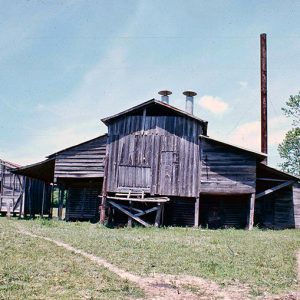calsfoundation@cals.org
Goodlett Gin
The Goodlett Gin is located at 799 Franklin Street in Historic Washington State Park in Washington (Hempstead County), once the county seat for Hempstead County and the last Confederate capital of the state of Arkansas. Constructed in 1883 in nearby Ozan (Hempstead County), the gin was added to the National Register of Historic Places in 1975 and moved to the park between 1978 and 1980 after it was purchased by the state. Reassembled in the park, it opened as a non-operating exhibit to the public in 1984.
David Goodlett was born on April 3, 1840, in Tippah County, Mississippi. After the death of his mother in 1844, Goodlett moved with his family to Camden (Ouachita County). In 1859, he moved to Hempstead County, where he worked as an overseer on a plantation. Enlisting in the Confederate army in 1861, he served in the Seventeenth Arkansas and was captured at the Battle of Port Hudson. At the conclusion of the war, he returned to Hempstead County and married Martha Reader in January 1867. The couple had seven children. Goodlett purchased land and worked as a farmer. In 1870, he held real estate valued at $1,000. Over the next decades, he continued to expand his holdings and, by 1890, held more than 1,200 acres. For several years, Goodlett used a nearby gin to process his cotton but decided to construct his own gin in 1883.
Using pine timber from his farm, Goodlett constructed a gin building and a scale house. The gin was originally operated by hand, supplemented by mule power. The gin operated in this manner until 1898, when it received an upgrade. The addition of new machinery, including a steam engine valued at $250, meant an increase in the speed of the gin. Other new machinery installed at this time included two sixty-saw stands and a boiler.
More improvements followed in 1911 with the installation of a continental distributer with a lint flue. The original boiler was replaced in the 1930s, along with the saw stands and feeders. The last update to the machinery was done in 1952, when a new set of piston rings was installed. Throughout the updates, the facility remained steam powered.
The building is two stories and was constructed next to a pond to provide the necessary water for the steam engine. At the time it was nominated to the National Register, it was topped with a metal roof. A one-story cotton seed house is connected to the gin by a shed roof. The exterior of the gin is covered with pine siding, and the floor of the structure is packed dirt. The first floor of the gin contains the steam engine, while the second floor houses the gin machinery.
The gin served as more than a location for the processing of cotton. Local farmers made syrup from sorghum and ribbon cane at the gin, and a grist mill made cornmeal at the facility. The multiple uses of the gin made it a popular year-round gathering place for farmers. By 1966, the volume of cotton, corn, and other crops produced near Ozan had decreased significantly, leading to the closure of the facility to commercial production.
Goodlett died on March 13, 1919, and is buried in Ozan. The gin remained in the Goodlett family until its purchase by the state. It was added to the National Register of Historic Places on January 17, 1975. After the facility moved to the park, it began serving as an educational display.
For additional information:
“Goodlett Gin.” National Register of Historic Places registration form. On file at Arkansas Historic Preservation Office, Little Rock, Arkansas. Online at http://www.arkansaspreservation.com/National-Register-Listings/PDF/HE0403.nr.pdf (accessed September 16, 2019).
Historic Washington State Park. http://www.historicwashingtonstatepark.com/ (accessed September 16, 2019).
David Sesser
Henderson State University
 Historic Preservation
Historic Preservation Ozan Lumber Company
Ozan Lumber Company Post-Reconstruction through the Gilded Age, 1875 through 1900
Post-Reconstruction through the Gilded Age, 1875 through 1900 Goodlett Gin
Goodlett Gin 




Comments
No comments on this entry yet.